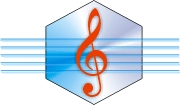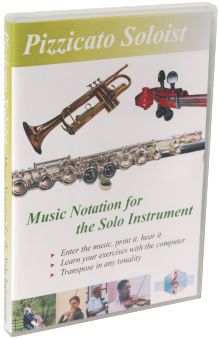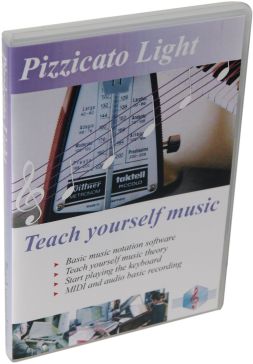The Music Typing Keyboard
Did you ever dream of an easy, intuitive, natural, fast and user friendly way to enter music with a computer?
This is now a reality, with the Music Typing Keyboard.

Your benefits
The main benefits of this keyboard are:
- The possibility to increase the speed with which you enter music
- A natural and intuitive logic for entering the music
If you are looking for a more logical way to enter music than by combining the computer keyboard, the MIDI keyboard and the mouse, this keyboard is for you.
Up to now, there was no keyboard specifically designed to enter music.
This keyboard was conceived right from the beginning to provide a natural and intuitive way to enter music.
The basic principle
The central part of the keyboard has one octave (7 notes) and a rest value, for three rhythmic values (eighth note, quarter note and half note). This forms a table of notes and rhythms. Two pairs of keys are used to shift octaves and rhythmic values very easily.
You can use the 10 fingers to type the notes, which helps you to accelerate music entry, as you get more and more accustomed to the keyboard. This is a music typing method.
The other keys give access to the various options needed while entering the music, like the accidentals, the ties, nuances,... They are placed in such a way that the most needed keys are closest to the hand.
You can use it with Finale and Sibelius
The keyboard is sold with Pizzicato Notation (but you can buy it alone if you already have Pizzicato). This software handles the interface with the keyboard and then exports a musicXML file, that you can use with most music software like Finale, Sibelius,... You can of course also arrange the page layout and print the score in Pizzicato if you prefer.
You can view this keyboard and the software as a fast and intuitive way to enter music. You export it to musicXML and you can continue to work with your favorite music software.
It is in some ways similar to using a music scanning program, as such a program is also an easy way to enter the music. In the case of the keyboard, it is a fast way to enter the content of a sheet music, whether you are copying it or you are composing it (Mozart, Bach and Beethoven would for sure have appreciated this keyboard!).
So, you can use the advantages of this new revolutionary method to enter notes, with most of the professional music software and edit and finalize (or sibeliusize...) the score in your favorite software.
Why is this keyboard a revolution?
The search for faster and more efficient methods to enter music with a computer started a long time ago. Nowadays, most music software offer several methods to enter the content of a staff on the screen, so as to publish it and/or arrange and play it.
The most common method is a tool palette offering the rhythmic values, which is used with the mouse to place the notes on the staff. Shortcuts from the computer keyboard make the process faster to select the rhythmic values, the pitch and various other utilities like slurs, ties, accidentals,...
If you connect a MIDI keyboard to the computer, you can often select the pitch of notes with that keyboard (but this implies you can use a music keyboard) and combine with the computer keyboard for rhythmic values.
You can also play the music in real time to get the score, but anyone who tried that knows that if the score is somewhat complex, even performed with precision, there are often corrections to do, which limits the efficiency of the method.
Furthermore, in most cases the shortcuts and details of the ways to enter music are different from software to software. If you change software, you must learn again how to use the shortcuts.
A computer keyboard has not been designed to enter music and its use for that purpose can only be a compromise, as it is first designed to enter text.
Similarly, a music piano keyboard has been designed to play a piece of music and not to enter music on a staff with all its subtle graphic details. The most obvious problem is that each note may be written in different ways, like F# or Gb. And when you play eighth notes, do you beam them by 2, 3 or 4? Do you assemble two simultaneous notes as a chord or as different voices? And so on... A MIDI keyboard is not designed to express this kind of details.
The use of the mouse, even if it is quite intuitive, is a relatively slow way to enter the music.
Here comes the Music Typing keyboard, as its advantage is that it has been specifically designed according to the needs of entering music with a computer. Its logic to enter notes and rhythmic values provides a quick learning curve and after some practice can considerably increase the speed to enter the music.
The central part of the keyboard is used to enter notes and rhythms. The other most important keys are placed around this central part so as to be easily accessible, like the accidentals, ties, dotted notes,...
To help you in the beginning, a window can display the various functions of the keyboard in an interactive way, but once you master the keyboard, this window is no more useful and the screen can be used fully to display the score you are writing.
Is it only a question of speed?
While its speed is indeed a major step forward of this new keyboard, its specific design to enter music makes it an intuitive, natural and user friendly tool, as it is perfectly adapted to the needs of music notation. It is therefore also well adapted in the field of music education.
Try it for yourself and see...
If not yet done, download the demo of Pizzicato 3.6. This software has a window that represents the keyboard and you can use it with the mouse. Of course, it does not offer the advantages of the real keyboard, but at least you can see how it works and how intuitive and natural it is to enter the music with it.
See the lesson on how to use this keyboard, on page:
www.arpegemusic.com/manual36/EN255.htm#J1

Get your own Music Typing Keyboard now!
Do not wait any longer and order this new music typing keyboard today by clicking on the following link:
and start to write or compose your music with this keyboard, for the pleasure of your eyes and ears!
Note : Presently, this keyboard only works on Windows, not on Mac.

All rights reserved for all countries
Pizzicato is a trademark owned by Arpege sprl







































